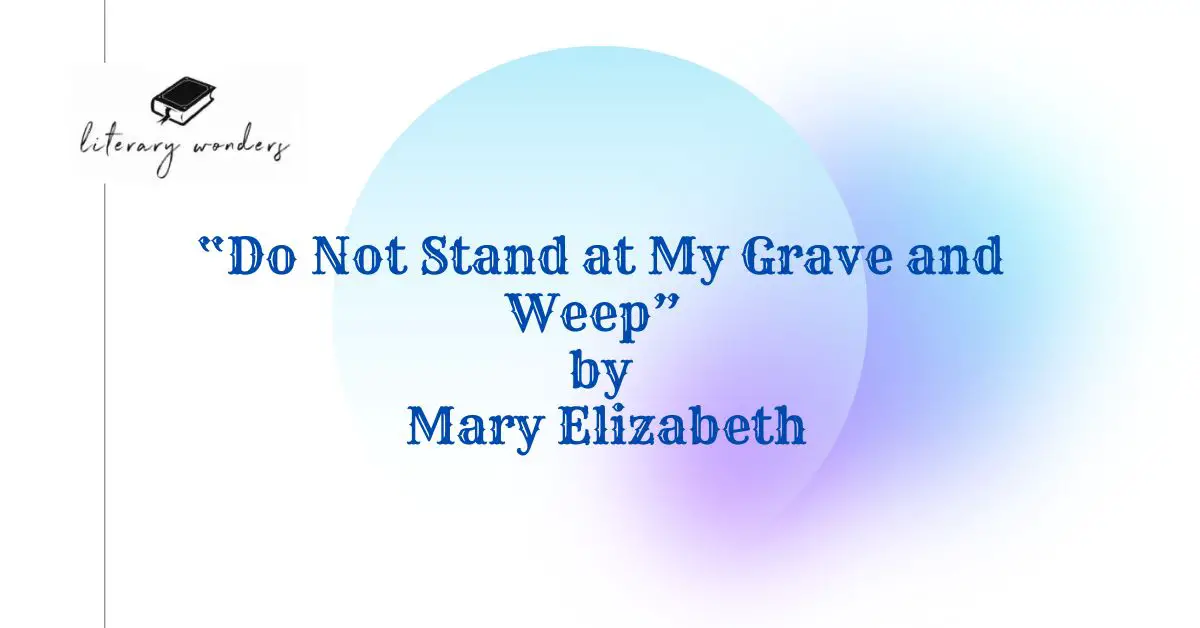
Summary of The Poem
- Popularity of Mary Elizabeth’s “Do Not Stand at My Grave and Weep“: “Do Not Stand at My Grave and Weep” is a suggestive poem penned by Mary Elizabeth, a well-known American author and poet. The poem is preoccupied with death and the afterlife. It suggests that one should find comfort in their faith and belief in an afterlife, alluding to the notion that the soul survives mortality. It acquired popularity, however, due to the accurate description of the life cycle.
- Representation of Hope in “Do Not Stand at My Grave and Weep”: The poem is a message of consolation to the reader, encouraging them not to lament at the speaker’s grave but to find comfort in the natural world and the memories they shared with her. The speaker advises the audience not to remain at her grave and weep but rather to go out into the world and discover the beauty and tranquility surrounding them. She reassures the reader that she is still present in the wind, the blossoms, and the birds, assuring them that she is not truly gone. The poem concludes with the speaker suggesting that her spirit lingers on in the world’s beauty.
- Major Themes in Mary Elizabeth’s “Do Not Stand at My Grave and Weep”: The poem’s main themes are the afterlife, hope, consolation, and solace. The poem describes the speaker’s demise and the accompanying emotions. The speaker advises the reader not to mourn at her grave because she is not truly deceased. She attempts to console and reassure the readers by assuring them that she will always be in their memories and thoughts. Additionally, the poem addresses the concept of the afterlife. It implies that the speaker is watching over the readers even after death. In addition, the speaker attempts to reassure the audience that death is not the end and that the souls of the deceased are still present in some manner. Thus, the poem implies that death is a natural part of the cycle of existence and that everyone must eventually confront it.
Analysis of Literary Devices Used in “Do Not Stand at My Grave and Weep”
Authors use literary devices to enhance the meaning or emotional impact of their writing. Mary has also used literary devices to make the poem alluring and enduring. The following is an analysis of the devices used in the poem.
- Assonance: Assonance is the repetition of vowel sounds in the same line, such as the sound of /e/ in “When you awaken in the morning’s hush” and the sound of /o/ in “I am the diamond that glints on snow.”
- Anaphora: It refers to the repetition of a word or phrase in the beginning of certain verses. In the first stanza of the poem, Mary repeats the phrase “I am” to emphasize the point:
“I am not there. I do not sleep.
I am a thousand winds that blow.
I am the diamond glints on snow.”
- Consonance: Consonance is the repetition of consonant sounds within the same line, such as /t/ in “I am the soft stars that shine at night” and /n/ in “When you awaken in the morning’s hush.”
- Enjambment: It is defined as a thought in verse that does not terminate at a line break but continues onto the following line. For instance,
“When you awaken in the morning’s hush
I am the swift uplifting rush”
- Epigraph: It is a device used in poetry, a quotation, or a sentence and is typically placed at the poem’s beginning to imply its overall theme. In the opening phrase, “Do not stand at my grave and weep,” Mary employs this literary device.
- Imagery: Imagery is utilized to evoke the five senses in readers’ minds. Mary uses imagery in this poem, such as “Do not stand at my grave and weep,” and “When you awaken in the morning’s hush,” and “I am the soft stars that shine at night.”
- Metaphor: A figure of speech compares two objects of distinct natures. The poet has extended the metaphor of mortality to demonstrate that life is even after death.
- Symbolism: Symbolism is the use of symbols to represent ideas and qualities by assigning them symbolic meanings distinct from their literal meanings. The poem contains symbols of mortality, sorrow, hope, and consolation.
The analysis demonstrates that the author has created a literary masterpiece with the use of these literary devices.
Analysis of the Use of Poetic Devices in “Do Not Stand at My Grave and Weep”
Poets utilize poetic devices to enhance the meaning, rhythm, and melody of their writing. The following is an analysis of the poetic devices used in the poem.
- Diction: The poem features descriptive diction with rhetorical devices, symbolism, and striking images.
- End Rhyme: End rhyme is used to make the stanza more melodic. This poem by Mary contains end rhymes such as “weep/sleep”, “blow/snow”, and “grain/rain.”
- Rhyme Scheme: The poem employs an ABAB rhyme scheme, and this pattern persists until the end.
FAQS About “Do Not Stand at My Grave and Weep”?
- Who is the author of the poem “Do Not Stand at My Grave and Weep”?
The poem, “Do Not Stand at My Grave and Weep” was authored by Mary Elizabeth, a renowned American writer and poet.
- What is the main theme of Mary Elizabeth’s “Do Not Stand at My Grave and Weep”?
The primary motifs explored within the poem encompass the concept of the afterlife, the notion of hope, the act of seeking solace, and the pursuit of consolation.
- How does Mary Elizabeth convey the idea of an afterlife in the poem?
Mary Elizabeth posits the concept of an existence beyond death by intimating that the speaker’s influence persists inside the realm of the living. The speaker metaphorically characterizes their essence as akin to the wind, blossoms, and birds, so suggesting the enduring nature of their spirit beyond the realm of mortality.
- What is the significance of the poem’s title “Do Not Stand at My Grave and Weep”?
The title implies the speaker’s desire for the reader to refrain from engaging in mourning or grieving activities at their burial site. Conversely, the author promotes the notion of seeking comfort and aesthetic appreciation in one’s surroundings, so suggesting that the speaker’s essence persists inside the realm of nature and recollections.
- What is the overall message of the poem, “Do Not Stand at My Grave and Weep”?
The poetry offers solace and encouragement to the reader. It urges the reader to forego conventional mourning rituals in favor of accepting the reality that life goes on even after death. The poem implies that the dead live on in the love and memory of their loved ones and in the planet’s natural beauty.
Suggested Readings

